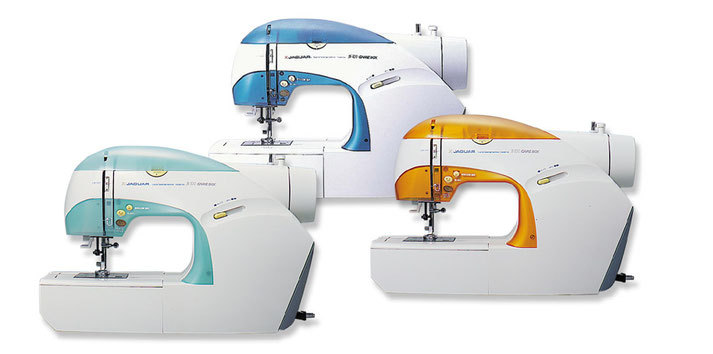|
History
The Jaguar International Corporation (株式会社ジャガーインターナショナルコーポレーション) was founded on July 24, 1949 under the name Maruzen Sewing Machine Co., Ltd. As the name implies, the company was manufacturing and selling sewing machines and sewing machine parts. In 1978, the domestic sales department became independent and established under the name Jaguar Sewing Machine Co., Ltd. and would merge back with the Maruzen Sewing Machine Co in 1989 under the name Jaguar Co., Ltd. Other branches of the company that were still operating under different names would slowly join under the new banner, until 1999 where the import/export business would change its name to Jaguar International Corporation.
Note: To simplify the conversation, let’s use Jaguar as the name of the company.
Since its inception, Jaguar has been a symbol of excellence, quite literally as they won the Sears Symbol of Excellence Award for ten consecutive years. This was on top of the many other awards the company won over the years.
By the beginning of the 90s’ as a small revolution in the sewing machine industry was brewing : the arrival of computerized sewing machines. In 1994, Singer releases the world first computerized sewing machine: the Quantum XL-1000. The Q![]() uantum series was targeting at professionals and the ones who turned sewing to arts. The Quantum XL-1000 offered built-in memory cards and was designed to facilitate embroidery works.
uantum series was targeting at professionals and the ones who turned sewing to arts. The Quantum XL-1000 offered built-in memory cards and was designed to facilitate embroidery works.
But computers in the early 90s were expensive so the price of computerized sewing machines were often in the thousands of dollars. Jaguar started working on its own computerized sewing machine in the late 90s, but knew the price point would be an issue. While pitching ideas, Jaguar came to the realization that there was already a small computer in millions of homes around the world in the form of the Nintendo Game Boy. The Game Boy offered connectivity to external device through its link cable, was powerful enough for the need of a computerized sewing machine, had simple control, a very decent price point and even offered the possibility of having multiple software if need be.
With that in mind, Jaguar reached out to Nintendo to acquire the license to produce an official accessory : the nu・yell JN-100. This would be Nintendo’s second incursion in the sewing machine world following the collaboration with Brother to release the Super Mario Embroidery World / Embroidery design card no. 17.
Release
Released in mid May 2000, the JN-100 was an immediate success. The JN-100 was available in 6 different colors : Pink, Clear White, Pale Green, Blueberry, Violet and Orange. Aside from the color, the sewing machine was available in two packages. The normal package, contained only the machine while the nu・yell deluxe, priced at 49,800, included a rock cutter, the foot controller and a Game Boy Pocket.
Later the same year, Jaguar announced the nuotto JN-2000, a more advance sewing machine with embroidery capabilities.
While most stores would only carry the Blueberry color, all colors were available online at launch, but as of mid-March 2001, sales for the Blueberry, Violet & Orange colors were temporarily discontinued online with a restocking planned around June 2001. But by June 2001, the restock had still not happened and Jaguar had to update their order form to remove these 3 colors. It took approximately another year and a half for these colors to become available again on the website, making the Violet and Orange color rarer than the rest.
While the JN-100 was distributed in Japan, Jaguar sold the international distribution right of the JN-100 to Singer who released it worldwide under the name Singer Izek 1500. The Izek 1500 had a moderate commercial success but was ever only available in Blueberry color.
Demise
The Game Boy Pocket also cease production in 2003, making it impossible for Jaguar to acquire additional units. But with the evolution in technology, the price of computerized sewing machines had already dropped significantly, rendering the JN-100 obsolete. And while the JN-100 was considered a success, the JN-2000 wasn’t killing any hope of a third collaboration between Jaguar and Nintendo.
Machine
The Jaguar was released in 6 colors in Japan. It was also released internationally under the Singer Izek 1500 brand.
 |  |  | |||
| Pink | Clear White | Pale Green | |||
 |  |  | |||
| Blueberry | Violet | Orange | |||
 | |||||
| IZEK 1500 |
Software
 | |||||
| Raku Raku Mishin |
The Raku x Raku Mishin (also known as the “Sewing Machine Operation Software” on the IZEK 1500), allowed the user to choose between 302 types of programmed sewing patterns. You could also save your favorite pattern for quick access and even create your own sewing patterns. While the JN-100 came with a Game Boy Pocket instead of a Game Boy Color to reduce the cost, the Raku Raku Mishin software is actually a Game Boy Color software.
Ads
 |

